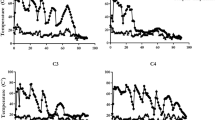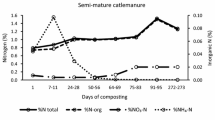Abstract
High quality composts were produced and applied at practical scale. The effects of these compost treatments on the health of potted plants were tested in a series of five laboratory trials. (1) Cress inoculated with Pythium ultimum was grown in pots containing 30% of two compost from two different origins. The disease developed with one compost, and was inhibited by the other. (2) Seedlings of cucumber were grown in substrate containing 0, 33, 67 or 100% of compost, and were inoculated with P. ultimum. With increasing proportions of compost, the disease was reduced. (3) Freshly steamed soil was amended with 10% compost (control: no compost). In the treated soil, far less nitrite was measured than in the control soil, and cucumbers were less attacked by P. ultimum. (4) Soil from a field treated with compost for five years was compared with soil not treated with compost. In the treated soil, cucumber seedlings were less attacked by P. ultimum, and lettuce seedlings were less attacked by Rhizoctonia solani, than in the control soil. (5) Barley was grown in pots containing 0, 10, 30 or 50% of composts from four different origins. With increasing proportions of compost, the incidence of powdery mildew was reduced, and there were significant differences between the compost origins.
The composition and the maturity of the compost influence the potential for suppression of plant disease. The management of the composting processes, and the oxygen supply in particular, seem to affect compost quality strongly. This has consequences on the storage management of the end products, as inappropriate storage measures can lead to reduction of product quality.
Access this chapter
Tax calculation will be finalised at checkout
Purchases are for personal use only
Preview
Unable to display preview. Download preview PDF.
Similar content being viewed by others
References
Boulter JI, Boland GJ, Trevors JT (2000) Compost: a study of the development process and end-product potential for suppression of turfgrass disease. J Microbiol Biotechnol 16: 115–134
De Ceuster TJJ, Hoitink HAJ (1999) Prospects for composts and biocontrol agents as substitutes for methyl bromide in biological control of plant diseases Compost Sci & Util 7: 6–15
Fuchs JG, Bieri B (2000) New biotests to measure the biological qualities of composts. Agrarforschung 7: 314–319
Hoitink HAJ, Stone AG, Han DY (1997) Suppression of plant diseases by composts. Hortsciencc 32: 184–187
Tuitert G, Szczech M, Bollen GJ (1998) Suppression of Rhizocronia solani in potting mixtures amended with compost made from organic household waste. Phytopathology 88: 764–773
Wolfe MS, Schwarzbach E (1978) The recent history of the evolution of barley powdery mildew in Europe. In Spencer DM ed. The powdery Mildews. Academic Press, London, pp 129–157
Zebarth, BJ, Neilsen GH, Hogue E, Neilsen D (1999) Influence of organic waste amendments on selected soil physical and chemical properties. Can J Soil Sci 79: 501504
Zhang W, Dick WA, Hoitink HAJ (1996) Compost-induced systemic acquired resistance in cucumber to Pythium root rot and anthracnose. Phytopathology 86 (10): 1066–1070
Zhang W, Han DY, Dick WA, Davis KR, Hoitink HAJ (1998) Compost and compost water extract-induced systemic acquired resistance in cucumber and Arahidopsis. Phytopathology 88 (5): 450–45
Author information
Authors and Affiliations
Editor information
Editors and Affiliations
Rights and permissions
Copyright information
© 2002 Springer-Verlag Berlin Heidelberg
About this paper
Cite this paper
Fuchs, J.G. (2002). Practical Use of Quality Compost for Plant Health and Vitality Improvement. In: Insam, H., Riddech, N., Klammer, S. (eds) Microbiology of Composting. Springer, Berlin, Heidelberg. https://doi.org/10.1007/978-3-662-08724-4_36
Download citation
DOI: https://doi.org/10.1007/978-3-662-08724-4_36
Publisher Name: Springer, Berlin, Heidelberg
Print ISBN: 978-3-642-08705-9
Online ISBN: 978-3-662-08724-4
eBook Packages: Springer Book Archive




